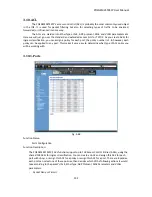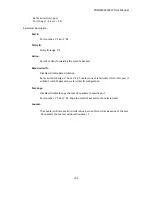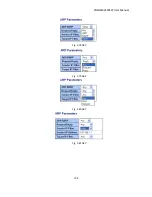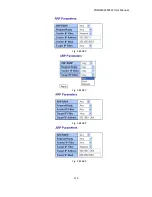
POEGEM24T4SFP
User
Manual
101
SNMP:
The
term
SNMP
here
is
used
for
the
activation
or
de
‐
activation
of
SNMP.
Default
is
Enable.
Get/Set/Trap
Community:
The
Community
name
is
used
as
a
password
for
authenticating,
if
the
requesting
network
management
unit
belongs
to
the
same
community
group.
If
they
both
don’t
have
the
same
community
name,
they
don’t
belong
to
the
same
group.
Hence,
the
requesting
network
management
unit
can’t
access
the
device
with
a
different
community
name
via
SNMP
protocol;
If
they
both
have
the
same
community
name,
they
can
talk
to
each
other.
The
Community
name
is
user
‐
definable
field
with
a
maximum
length
of
15
characters
and
is
case
sensitive.
There
is
not
allowed
to
be
any
blank
spaces
in
the
community
name
string.
Any
printable
character
is
allowed.
The
community
name
for
each
function
works
independently.
Each
function
has
its
own
community
name.
Say,
the
community
name
for
GET
only
works
for
GET
function
and
can’t
be
applied
to
other
function
such
as
SET
and
Trap.
Default
SNMP
function
:
Enable
Default
community
name
for
GET:
public
Default
community
name
for
SET:
private
Default
community
name
for
Trap:
public
Default
Set
function
:
Enable
Default
trap
host
IP
address:
0.0.0.0
Default
port
number
:162
Trap:
In
the
switch,
there
are
6
trap
hosts
supported.
Each
of
them
has
its
own
community
name
and
IP
address;
this
is
user
‐
definable.
To
set
up
a
trap
host
means
to
create
a
trap
manager
by
assigning
an
IP
address
to
host
the
trap
message.
In
other
words,
the
trap
host
is
a
network
management
unit
receiving
the
trap
message
from
the
managed
switch
with
SNMP
agent
issuing
the
trap
message;
6
trap
hosts
can
be
configured.
For
each
public
trap,
the
switch
supports
the
trap
event
Cold
Start,
Warm
Start,
Link
Down,
Link
Up
and
Authentication
Failure
Trap.
They
can
be
enabled
or
disabled
individually.
When
enabled,
the
corresponding
trap
will
actively
send
a
trap
message
to
the
trap
host,
when
a
trap
happens.
If
all
public
traps
are
disabled,
no
public
trap
message
will
be
sent.
Default
for
all
public
traps:
Enabled
Summary of Contents for POEGEM24T4SFP
Page 68: ...POEGEM24T4SFP User Manual 68 Move to the previous page Next Page Move to the next page...
Page 82: ...POEGEM24T4SFP User Manual 82 Fig 3 42 Fig 3 43 Fig 3 44...
Page 89: ...POEGEM24T4SFP User Manual 89 Fig 3 48...
Page 106: ...POEGEM24T4SFP User Manual 106 Fig 3 71 Fig 3 72...
Page 108: ...POEGEM24T4SFP User Manual 108 Fig 3 75 Fig 3 76 Fig 3 77 ARP...
Page 109: ...POEGEM24T4SFP User Manual 109 Fig 3 78 ARP Fig 3 79 ARP Fig 3 80 ARP Fig 3 81 ARP...
Page 110: ...POEGEM24T4SFP User Manual 110 Fig 3 82 ARP Fig 3 83 ARP Fig 3 84 ARP Fig 3 85 ARP...
Page 111: ...POEGEM24T4SFP User Manual 111 Fig 3 86 ARP Fig 3 87 ARP Fig 3 88 ARP Fig 3 89 ARP Fig 3 90 ARP...
Page 112: ...POEGEM24T4SFP User Manual 112 Fig 3 91 IPv4 Fig 3 92 IPv4 Fig 3 93 IPv4...
Page 115: ...POEGEM24T4SFP User Manual 115 Fig 3 105 IPv4 Fig 3 106 IPv4 Fig 3 107 IPv4...
Page 116: ...POEGEM24T4SFP User Manual 116 Fig 3 108 IPv4 Fig 3 109 IPv4 Fig 3 110 IPv4...
Page 117: ...POEGEM24T4SFP User Manual 117 Fig 3 111 IPv4 Fig 3 112 IPv4 Fig 3 113 IPv4 Fig 3 114 IPv4...
Page 118: ...POEGEM24T4SFP User Manual 118 Fig 3 115 IPv4 Fig 3 116 IPv4 Fig 3 117 IPv4...
Page 119: ...POEGEM24T4SFP User Manual 119 Fig 3 118 IPv4 Fig 3 119 IPv4 Fig 3 120 IPv4...
Page 120: ...POEGEM24T4SFP User Manual 120 Fig 3 121 Action Fig 3 122 Rate Limiter...
Page 121: ...POEGEM24T4SFP User Manual 121 Fig 3 123 Port Copy Fig 3 124 DMAC Filter...
Page 211: ...POEGEM24T4SFP User Manual 211 Fig 4 3...
Page 238: ...POEGEM24T4SFP User Manual 238 2 1 3 1 4 1 5 1 POEGEM24T4SFP acl...
















































